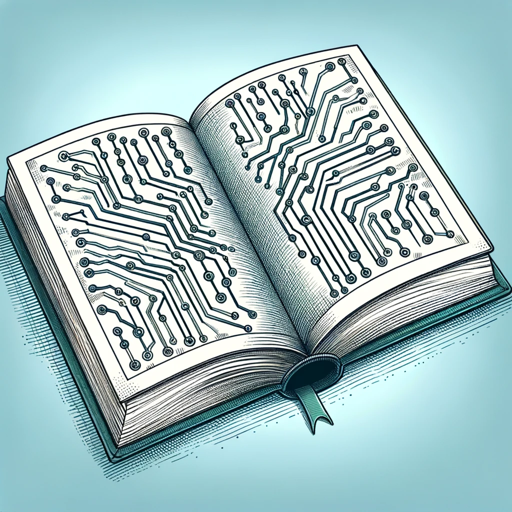electronic circuits-TTL logic circuit analogies
AI-Powered Circuit Analogy Generator
Show a TTL circuit that reminds me of a childhood memory.
Show a TTL circuit of a very simple finite-state machine.
Related Tools
Load More
Electric and Electronic Circuits Tutor
Tutor in Electric and Electronic Circuits, detailed and understanding.
Circuit Sage
AI Expert on Electronics and Embedded Systems.

Electronics and Circuit Analysis
Expert in electronics circuits analysis, adept at handling ambiguous queries.

Student - Electrical and Electronics Engineering
Enthusiastically delves into circuit theory, signal processing, and electronics. Spends time in labs testing electrical systems and creating hardware prototypes. Requires updated resources on semiconductor physics, automation systems, and electrical safet

Electronics Hardware Design GPT
Expert in electronics and hardware design, circuit and PCB guidance

⚡️ Circuit Solver Assistant 🛠️
Your go-to AI for electrical engineering! From circuit analysis to power system optimization, get expert help with complex calculations and design! 🔌🤖
20.0 / 5 (200 votes)
Introduction to Electronic Circuits
Electronic circuits are interconnected paths for electrical currents, constructed using various electronic components like resistors, capacitors, inductors, diodes, and transistors. These circuits serve as the foundation for modern electronics, enabling the functionality of a wide range of devices from small gadgets to large industrial machines. The purpose of designing these circuits varies from simple tasks like controlling a light bulb to complex ones such as processing data in computers. For example, in a smartphone, multiple circuits work together to handle tasks such as touch input processing, battery management, and wireless communication.

Main Functions of Electronic Circuits
Signal Amplification
Example
Audio Amplifiers
Scenario
In a home audio system, an electronic circuit amplifies the weak signal from an audio source (like a CD player) to drive speakers. This amplification allows the audio to be played at various volumes while maintaining sound quality.
Data Processing
Example
Microprocessors
Scenario
In computers and smartphones, microprocessors are electronic circuits that process large amounts of data. These circuits perform calculations, manage operations, and execute programs, making them the core component of computing devices.
Power Conversion
Example
Power Supplies
Scenario
Electronic circuits in power supplies convert AC power from the outlet to the DC power required by electronic devices. This conversion is critical for safely and efficiently powering a wide range of devices from laptops to industrial equipment.
Ideal Users of Electronic Circuit Services
Electronics Hobbyists
These are individuals who build and experiment with electronic circuits as a hobby. They benefit from electronic circuit services by accessing tools, kits, and design software to create custom circuits for projects like robotics, home automation, or DIY electronics.
Engineers and Designers
Professionals in fields like electrical engineering, embedded systems, and hardware design heavily rely on electronic circuit services. They use these services to design, simulate, and test circuits for applications ranging from consumer electronics to aerospace systems.

Guidelines for Using Electronic Circuits
Step 1
Visit aichatonline.org for a free trial without login, also no need for ChatGPT Plus.
Step 2
Understand the basics of TTL logic circuits, including components like gates, flip-flops, and counters. Familiarize yourself with circuit diagrams and how to interpret them.
Step 3
Select your use case (e.g., academic writing, analogies, learning support) to guide the circuit design process. Choose the correct circuit elements that match the logical requirements of your scenario.
Step 4
Assemble the circuit using a digital circuit simulator or on a breadboard. Ensure each component is correctly connected based on the intended logic flow.
Step 5
Test the circuit in various scenarios to validate its functionality. Adjust components as necessary to achieve the desired output. Document your results and refine the circuit for efficiency.
Try other advanced and practical GPTs
Electric and Electronic Circuits Tutor
AI-powered insights for electric circuits

Defender Zim
AI-driven cybersecurity insights, with a twist!

Israel Defender
AI-powered defense for Israel’s legitimacy.

GPT Defender
AI-powered protection for your GPT.
Simple Sentences
AI-Powered English Improvement Tool

Album Art Designer
AI-powered album cover design.

Electronic Music Producer
AI-powered assistance for music producers

Electronics and Circuit Analysis
AI-powered Circuit Analysis and Design

Your Favorite Attending
AI-powered clinical decisions, simplified.

Christian Prayer - Bible CoPilot
Empowering Your Prayer Life with AI

Auto Expert
AI-powered solutions for automotive excellence.

dungeons and dragons DnD
AI-Powered Dungeon Master for Epic Adventures

- Learning Support
- Circuit Design
- Simulations
- Logical Analysis
- STEM Education
Q&A About Electronic Circuits
What are TTL logic circuits?
TTL (Transistor-Transistor Logic) circuits are a type of digital logic circuit built using bipolar junction transistors (BJTs) as the primary components. They are used in applications where fast processing speeds are required.
How do I interpret a circuit diagram?
Circuit diagrams use symbols to represent different components like resistors, capacitors, and logic gates. Understanding these symbols and how they connect is essential for reading and designing circuits.
What tools can I use to design circuits?
You can use digital circuit simulators like Logisim or hardware tools like breadboards and microcontrollers for designing and testing circuits. Online resources and educational kits can also provide hands-on learning experiences.
Can electronic circuits be used for learning support?
Yes, electronic circuits can be used to create interactive learning tools, simulate real-world systems, and teach logical reasoning. They are particularly useful in STEM education and robotics.
What is the difference between analog and digital circuits?
Analog circuits process continuous signals, while digital circuits handle discrete signals, typically in the form of binary values (0s and 1s). Digital circuits are more common in modern computing and electronics.